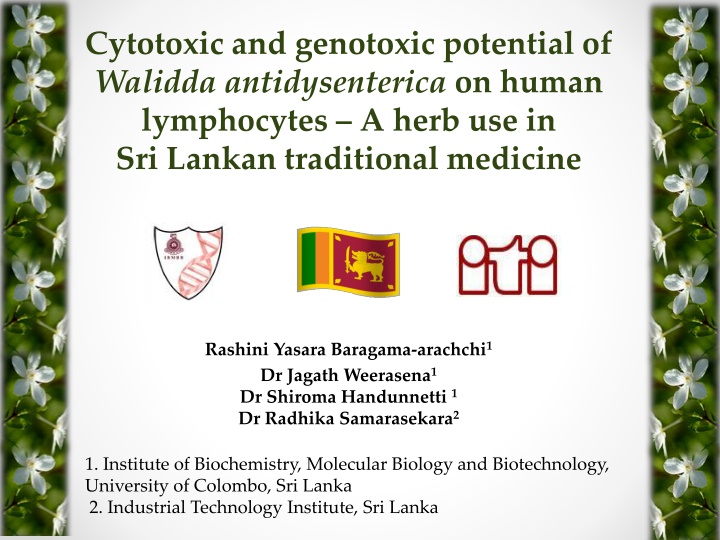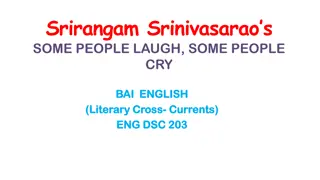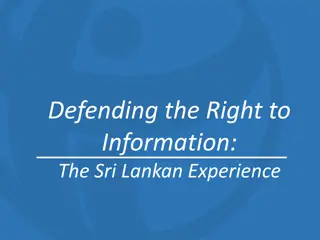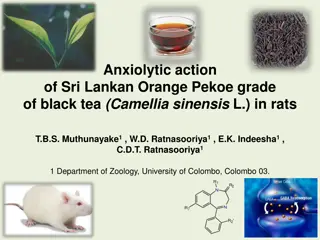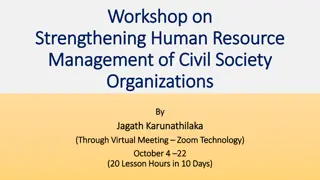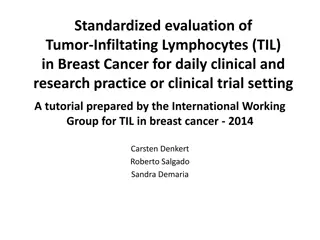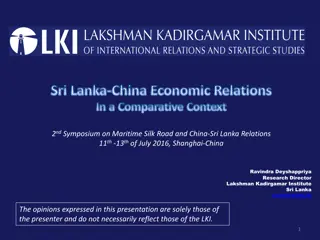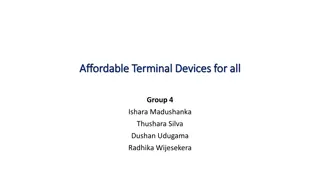Cytotoxic and Genotoxic Potential of Walidda Antidysenterica on Human Lymphocytes: A Study in Sri Lankan Traditional Medicine
Investigating the cytotoxic and genotoxic effects of Walidda antidysenterica extracts on human lymphocytes in Sri Lankan traditional medicine. The plant is widely used for its diverse medicinal properties, including treating various diseases and promoting overall health. The study aims to understand the potential benefits and risks associated with the plant's use. Various plant parts such as bark, leaves, and flowers are being studied for their phytochemical composition and biological effects.
Download Presentation

Please find below an Image/Link to download the presentation.
The content on the website is provided AS IS for your information and personal use only. It may not be sold, licensed, or shared on other websites without obtaining consent from the author.If you encounter any issues during the download, it is possible that the publisher has removed the file from their server.
You are allowed to download the files provided on this website for personal or commercial use, subject to the condition that they are used lawfully. All files are the property of their respective owners.
The content on the website is provided AS IS for your information and personal use only. It may not be sold, licensed, or shared on other websites without obtaining consent from the author.
E N D
Presentation Transcript
Cytotoxic and genotoxic potential of Walidda antidysenterica on human lymphocytes A herb use in Sri Lankan traditional medicine Rashini Yasara Baragama-arachchi1 Dr Jagath Weerasena1 Dr Shiroma Handunnetti 1 Dr Radhika Samarasekara2 1. Institute of Biochemistry, Molecular Biology and Biotechnology, University of Colombo, Sri Lanka 2. Industrial Technology Institute, Sri Lanka
Walidda antidysenterica Family : Apocynaceae Widely used in traditional medicine to treat a broad spectrum of diseases antidontalgic and anti-inflammatory properties Bark - has anti-microbial, antidiarrheal, The seeds are astringent, antidiarrheal and febrifuge Leaves possess antioxidant and antibacterial properties (Wickramaratne et al; 2015)
Walidda antidysenterica Plant part Remedy for Bark Juice extracted is administrated to treat mouth sores, dysentry, dropsy (Edema ), Tonsillitis, Bronchitis Seeds Fevers, diarrhoea and dysentery, intestinal worms, Antibilious, promote conception, making the muscles of vaginal tissue stronger and firmer after delivery Flowers Snake bites, Russell s viper bites Leaves Skin disorders, Psoriasis, Nonspecific dermatitis , antitubercular Roots Hemorrhage (Chopra et al; 1986, Frondozo et al; 2009 Shah et al; 2010)
Walidda antidysenterica Phytochemicals include alkaloids, flavonoids, sterols and quinine More than 30 alkaloids have been isolated from W. antidysenterica and most were isolated from the stem bark (Ganapathy et al, 2009) It has been reported that W. antidysenterica contain a potent genotoxic compound (pyrrolyzidine alkaloids) (Arseculeratne et al, 1981) Pyrrolizidine alkaloid (Shah et al, 2010)
Objectives of the study To investigate the in vitro cytotoxic and genotoxic potential of ethanol leaf, stem bark and flower extracts of W. antidysenterica
Plant extract preparation Dust free leaves, flowers & stem bark were dried under the shade for 2 weeks Leaves Stem bark Flowers Kept at RT for three nights
Plant extract preparation Rotary evaporated under the vacuum at 40 C Vacuum filtered (Celite filter) Stirred at 30 rpm for an hour at RT Further dried By exposing to air for overnight at RT Passing N2 gas Stem Bark Leaf Flower Transferred to pre-weighed glass bottles
Lymphocytes purification Dilute + + Blood layered over Histopaque Whole blood (1666 l) PBS (1666 l) Diluted blood Histopaque (1ml) 800 x g for 20 min at 4 C without breaks
Cell culture and in vitro treatment Overnight incubation in a humidified CO2 incubator Wells seeded with cells (2x105) Treated with different concentrations of plant extracts 10,20,30,40,50,100,200, 400,800 g/ml
Cytotoxicity assessment Trypan Blue dye exclusion assay was carried out to check the viability after treatment Concentrations, which retained >70% viability was selected for Comet assay
Genotoxicity assessment by Comet assay Base slide preparation Embedding cells in LMPA Preparation of microgel slides Cell lysis Alkaline unwinding and electrophoresis Visualization and comet scoring Statistical analysis
Comet scoring and statistical analysis Assay was performed in triplicates for each concentration 100 cells per each concentration were scored Casp 1.2.3b.1 image analysis software was used to assess the quantitative and qualitative extent of DNA damage in the cell Results were analyzed using SPSS statistical software (version17.0) The results were considered to be significantly different at P < 0.05
Cytotoxic potential of W. antidysenterica 120 Percentage viability (%) 100 WLE 80 60 WSE 40 WFE 20 0 0 10 20 30 40 50 100 200 400 800 Concentration ( g/ml) WLE- W. antidysenterica leaves extract WSE- W. antidysenterica stem bark extract WFE- W. antidysenterica flower extract viability of lymphocytes (n=100) with treated concentrations of plant extracts. Results of 3 independent experiments
Comets of control cells Positive Control (C+) 200 M H2O2 Negative Control (C-) Vehicle (DMSO)+ Culture media
Effect of different ELE concentrations on comet formation ELE 40 g/ml 50 g/ml 20 g/ml 30 g/ml 10 g/ml
Effect of different ESE concentrations on comet formation ESE 50 g/ml 40 g/ml 30 g/ml 20 g/ml 10 g/ml
Effect of different EFE concentrations on comet formation EFE 400 g/ml 800 g/ml 50 g/ml 200 g/ml 100 g/ml
Genotoxic potential of ELE, ESE and EFE 120 As detected by TM 100 Arbritary Units TM 80 Dose dependency * 60 40 TM : r = 0.921 ; p = 0.026 20 0 C (-) C (+) 10 20 30 40 50 Concentration ( g/ml) 120 100 Arbritary Units TM 80 60 TM : r = 0.793 ; p = 0.110 40 20 0 C (-) C (+) 10 20 30 40 50 Concentration ( g/ml) 120 100 Arbritary Unit 80 TM TM : r = 0.952 ; p = 0.013 60 40 20 0 C (-) C (+) 50 100 200 400 800 Concentration ( g/ml)
Genotoxic potential of ELE, ESE and EFE 50 As detected by Tail DNA percentage (%) Tail DNA % % Tail DNA 40 30 20 r = 0.928 ; p = 0.023 10 0 C (-) C (+) 10 20 30 40 50 Concentration ( g/ml) 50 Tail DNA (%) % Tail DNA 40 30 r = 0.899 ; p = 0.038 20 10 0 C (-) C (+) 10 20 30 40 50 Concentration ( g/ml) 50 Tail DNA (%) % Tail DNA 40 30 r = 0.995 ; p = 0.000 20 10 0 p < 0.05 C (-) C (+) 50 100 200 400 800 Concentration ( g/ml)
Summary of genotoxicity with respect to the % Tail DNA 10 20 30 30 40 25 Tail DNA percentage (%) 50 100 200 20 400 800 800 15 400 200 100 10 50 40 Concentration ( g/ml) 5 30 20 0 10 ELE ESE EFE
Conclusions Ethanol flower extract of Walidda antidysenterica was neither cytotoxic nor genotoxicity compared to other plant parts ESB showed moderate cytotoxicity while ELE showed the highest cytotoxic effect High concentrations of leaves showed significant, dose- dependent genotoxicity where as stem barks showed moderate genotoxicity. Presence of Pyrrolizidine alkaloids (e.g -: conessine, conessimine, iso-conessimine etc.) may account for the genotoxicity of leaves Use of leaves to treat skin diseases can be justified with our study However long term use is not recommended
References 1. Albertini RJ, Anderson D, Douglas GR, Hagmar L, Hemminki K, Merlo F et al. IPCS guidelines for the monitoring of genotoxic effects of carcinogens in humans. (2000) Mutation Research :463 ;111 172 2. Arseculeratne SN, Gunathilaka AA and Panabokke RG. Studies on medicinal plants of Sri Lanka: Occurrence of Pyrrolizidine alkaloids and hepatotoxic properties in some traditional medicinal herbs. (1981) Journal of Ethnopharmacology: 4(2); 159-177 3. Azqueta A, Gutzkow KB, Brunborg G and Collins AR. Towards a more reliable comet assay: Optimising agarose concentration, unwinding time and electrophoresis conditions (2011) Mutation Research: 724; 41-45 4. Chopra RN, Nayar SL, Chopra IC, Asolkar LV, Kakkar KK. Glossary of Indian medicinal plants ; [with] Supplement (1986)Council of Scientific & Industrial Research, Edition3 5. Collins AR. The comet assay for DNA damage and repair: principles, applications, and limitations. (2004b) Molecular Biotechnology: 26(3); 249-61 6. Collins AR, Oscozi AA,Brunborg G, Gaiva I, Giovannelli L, Kruszewski M et al. REVIEW:The comet assay: topical issues. (2008) Mutagenesis: 23 (3 ) ;143 151
References 7. Frondozo SP,Villaflores OB, Paragas EM, Franzblau SG, Wang YH, Aguinaldo AM. (1970- 2009) Phytochemical and antitubercular screening on the extracts of the aerial parts of white angel (wrightia antidysenterica r. br.); isolation of metabolities from the chloroform leaf extract. UST College of Science Journal; University of Santo Tomas 8. Ganapathy PSS, Ramachandra YL, Sudeep HV, Bellamakondi PK, Achar KGS and Rai SP. Pharmacognostic and phytochemical evaluation of Holarrhena antidysenterica Wall. (2009) The Asian and Australasian Journal of Plant Science and Biotechnology: 3(1); 47-50 9. Hartmann A, Agurell E, Beevers C, Brendler-Schwaab S, Burlinson B, Clay P et al. Recommendations for conducting the in vivo alkaline Comet assay. (2003) Mutagenesis:18(1); 45 51 10. Morley N, Rapp A, Dittmar H, Salter L, Gould D, Greulich KO et al. UVA-induced apoptosis studied by the new apo/necro-Comet-assay which distinguishes viable, apoptotic and necrotic cells. (2006) Mutagenesis: 21( 2 ); 105 114 11. Nandhakumar S, Parasuraman S, Shanmugam M, Rao KR, Chand P and BhatBV. Evaluation of DNA damage using single-cell gel electrophoresis (Comet Assay). (2011) Journal of Pharmacology and Pharmacotherapeutics: 2(2); 107 111 12. World Health Organization. Pyrrolizidine alkaloids,health and safety guide.IPCS International Programme on chemical safety (Health and safety guide N0.26)1989 13. Wickramaratne MN, Gunatilake LP, Anuradha NGD, Godavillathanna AN, Perera MGN, and Nicholas I. Antioxidant Activity and Antibacterial Activity of Walidda antidysenterica. 2015; Journal of Pharmacognosy and Phytochemistry :24(2);121-126
Acknowledgement National Science Foundation, Sri Lanka for financial support ,
